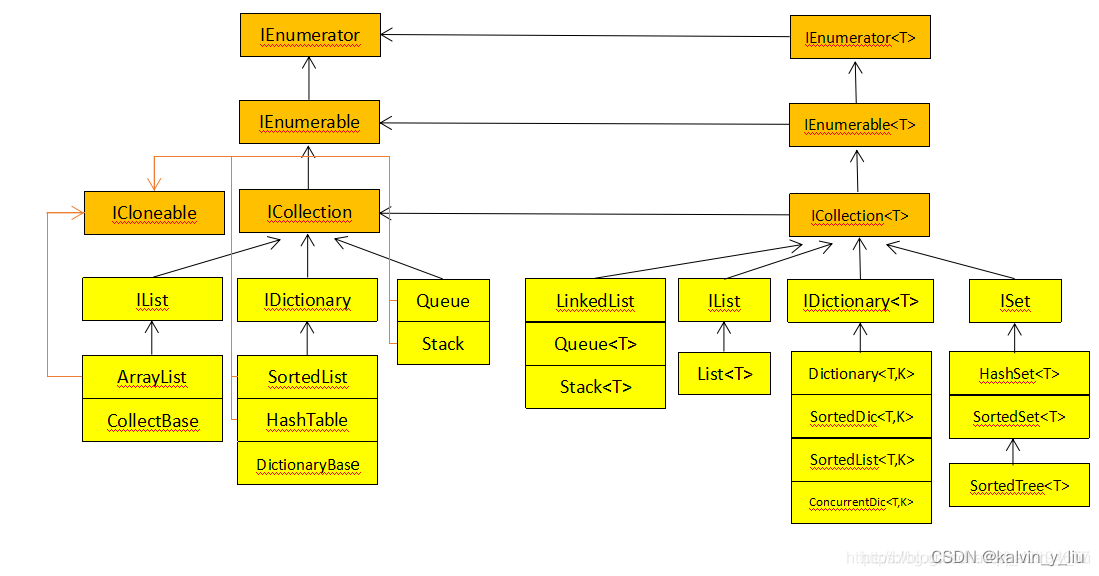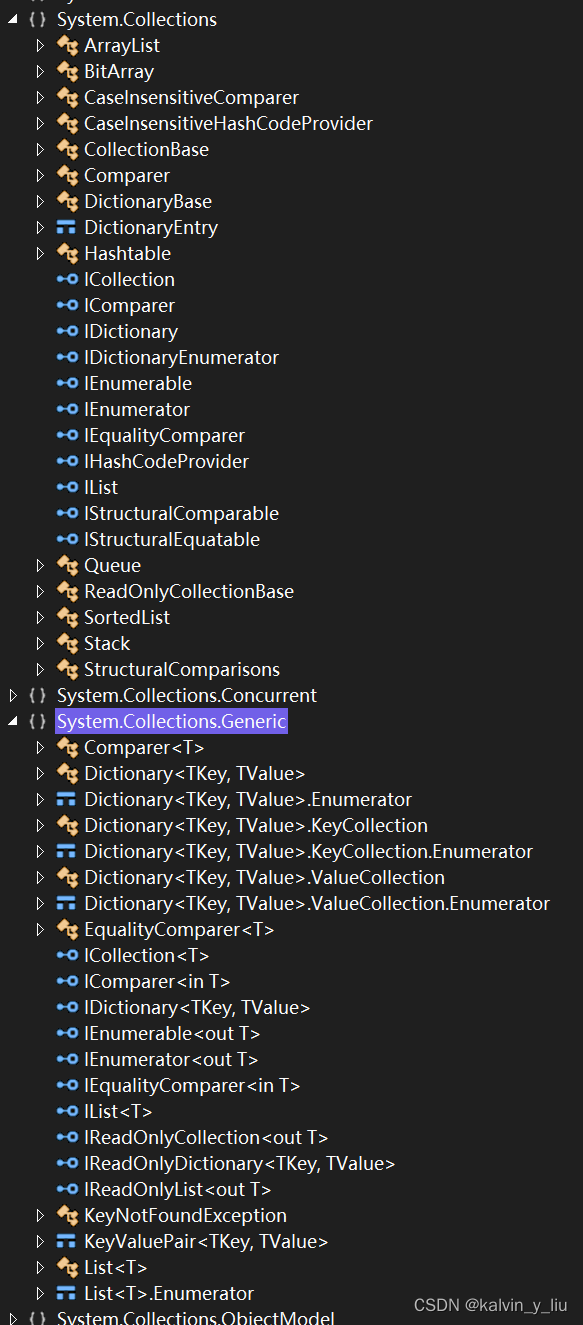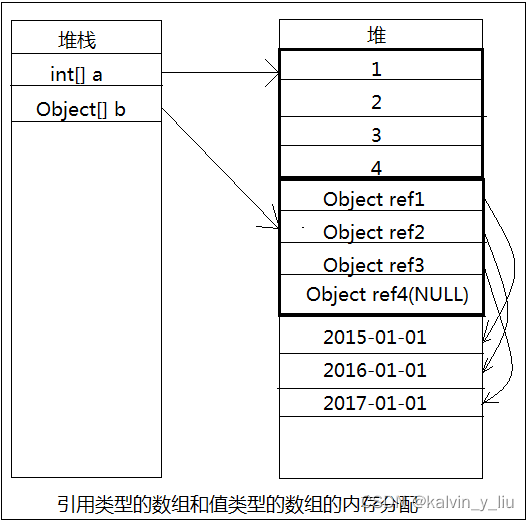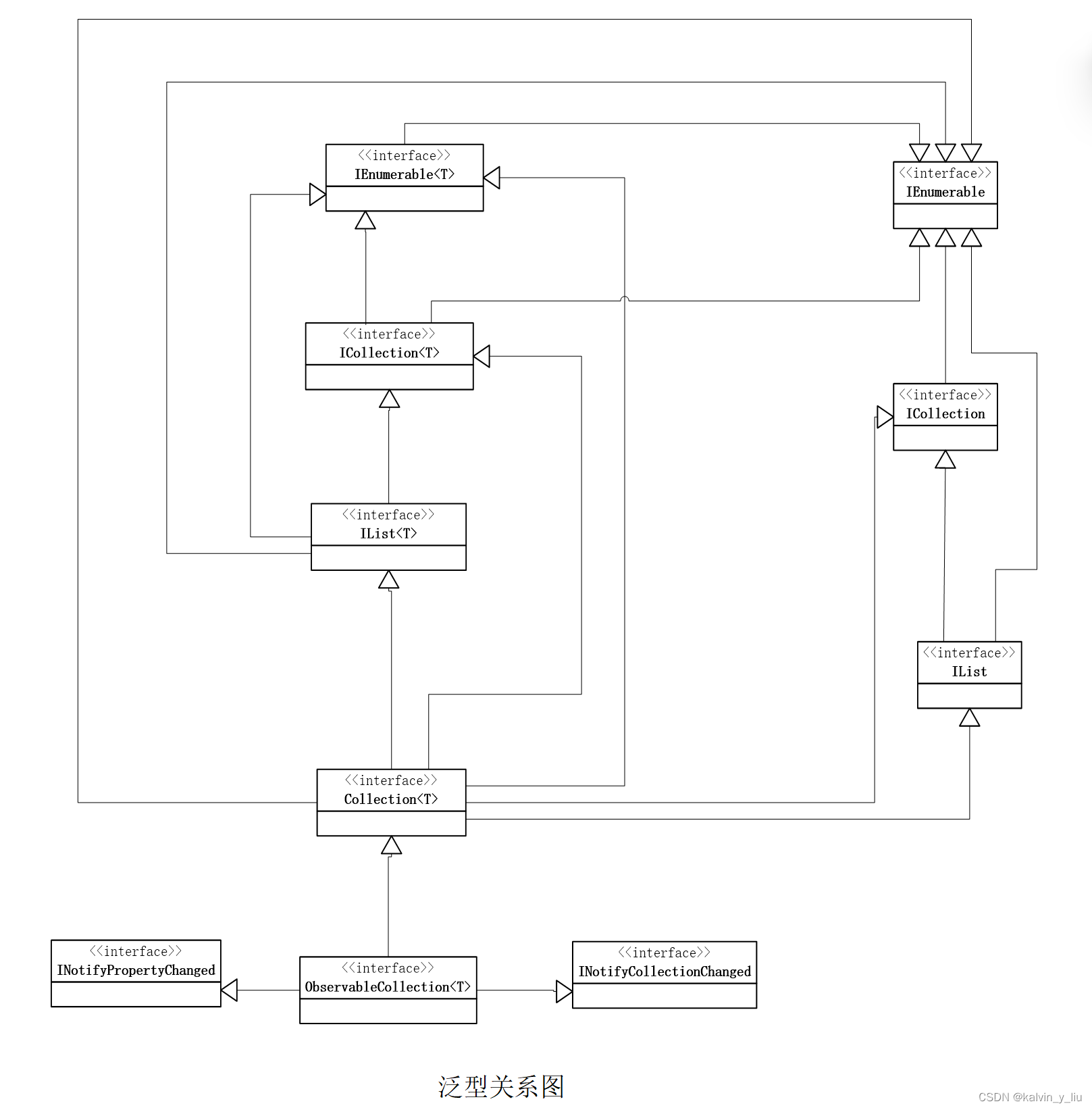-
集合和泛型
泛型 和 集合
更专业的解析强点击上面蓝色文字。
集合类底层接口关系图
所有的集合都是继承自IEnumerable。集合总体可以分为以下几类:
- 关联/非关联型集合,
- 顺序/随机访问集合,
- 顺序/无序集合,
- 泛型/非泛型集合,
- 线程集合。
各集合类底层接口关系图:


泛型
为什么要有泛型
我们常常需要创建能用于任何数据类型的类或方法,多态和继承并不总能"药到病除"。在.Net2.0之前,如果方法需要适配任意类型,就只能使用System.Object。这会带来两个问题。
1.类型安全
2.装箱泛型约束
泛型约束告诉编译器,在使用某个泛型时,只有某些类型能够作为泛型实参。
每个泛型参数可以有至多一个主要约束,泛型的主要约束是指指定泛型参数必须是或者继承自某个引用类型,有两个特殊的主要约束:class和struct,分别代表泛型参数引用类型和值类型。
每个泛型参数可以有无数个次要约束,次要约束和主要约束的语法基本相同,但它规定的是某个泛型参数必须实现所有次要约束指定的接口。
public class ClassT1<T> where T : Exception { private T myException; public ClassT1(T t) { myException = t; } public override string ToString() { //主要约束保证了myException拥有source成员 return myException.Source; } } public class ClassT2<T> where T : class { private T myT; public void Clear() { //T是引用类型,可以置null myT = null; } } public class ClassT3<T> where T : struct { private T myT; public override string ToString() { //T是值类型,不会发生NullReferenceException异常 return myT.ToString(); } }- 1
- 2
- 3
- 4
- 5
- 6
- 7
- 8
- 9
- 10
- 11
- 12
- 13
- 14
- 15
- 16
- 17
- 18
- 19
- 20
- 21
- 22
- 23
- 24
- 25
- 26
- 27
- 28
- 29
- 30
- 31
泛型主要约束示例:
public T Create<T>(T element) where T : EntityBase { } public T Create<T>(T element) where T : EntityBase { } public T Create<T>(T element) where T : IFormattable { } public T Create<T>(T element) where T : new() { } public T Create<T>(T element) where T : class { } public T Create<T>(T element) where T : struct { }- 1
- 2
- 3
- 4
- 5
- 6
- 7
- 8
- 9
- 10
- 11
- 12
- 13
- 14
- 15
- 16
- 17
- 18
- 19
1 int[]是引用类型还是值类型
数组类型是一族类型,它们都继承自System.Array,而System.Array又继承自System.Object。所有数组的类型都是引用类型。
引用类型的数组和值类型的数组的内存分配:

集合

祖宗: IEnumerable此接口只有一个方法 GetEnumerator();
是FrameWork为了实现
迭代器模式设计的接口。
所有继承了IEnumerable的类,要使用foreach迭代器时,就需要使用该方法。因此也只有实现了该接口的类才可以使用foreach。ICollection继承自IEnumerable,IList继承自ICollection
这两个接口都是为了给集合提供一些公用的方法。只是分了两个层次,IList比ICollection多几个方法,增加,移除成员。
可以简单理解为:ICollection主要针对静态集合;IList主要针对动态集合。IListIList,ICollection,IEnumerable在命名空间System.Collections中。
IList,ICollection,IEnumerable。在System.Collections.Generic 命名空间中。
IList,ICollection,IEnumerable。是2.0引入泛型以后新增的。主要是提高重用性与类型安全。
IEnumerable继承自IEnumerable
ICollection继承自IEnumerable
IList继承自ICollection
因此可以完全使用泛型接口,而放弃使用ICollection和IList。泛型接口提供了更好的类型安全和编译时的检验。
补充:
IEnumerable和IEnumerable都只有一个方法。
ICollection和ICollection的结构是不一样的。ICollection比ICollection多几个方法。它包含了几个IList中的几个方法。也许是对以前的改进。
————————————————ICollection主要针对静态集合;IList主要针对动态集合
IEnumerable继承自IEnumerable
ICollection继承自IEnumerable
IList继承自ICollectionIEnumerable接口
实现了IEnumerable接口的集合表明该集合能够提供一个enumerator(枚举器)对象,支持当前的遍历集合。 IEnumerable接口只有一个成员GetEnumerator()方法。- 1
- 2
IEnumerator接口
IEnumerator接口是只读的,包括以下三个成员:
- MoveNext()方法调整遍历指针移向集合的下一个元素。
注意,遍历指针的初始位置是集合中第一个元素的前面。要指向第一个元素,必须先调用一次MoveNext()方法。该方法返回一个布尔值,如果成功遍历到下一个元素,则返回true;如果指针移出末尾,则返回false。
- Reset()方法用于设置遍历指针指向初始位置,即集合中第一个元素的前面。
- Current属性返回集合中当前对象的引用。
IEnumerable和IEnumerator的区别
1、一个Collection要支持foreach方式的遍历,必须实现IEnumerable接口(亦即,必须以某种方式返回IEnumerator object)。 2、IEnumerator object具体实现了iterator(通过MoveNext(),Reset(),Current)。 3、从这两个接口的用词选择上,也可以看出其不同:IEnumerable是一个声明式的接口,声明实现该接口的class是“可枚举 (enumerable)”的,但并没有说明如何实现枚举器(iterator); IEnumerator是一个实现式的接口,IEnumerator object就是一个iterator。 4、IEnumerable和IEnumerator通过IEnumerable的GetEnumerator()方法建立了连接, client可以通过IEnumerable的GetEnumerator()得到IEnumerator object,在这个意义上, 将GetEnumerator()看作IEnumerator object的factory method也未尝不可。- 1
- 2
- 3
- 4
- 5
- 6
- 7
- 8
ICollection集合
该接口是IEnumerable接口的子接口,定义了集合的大小、IEnumerator接口和同步方法。在IEnumerable接口的基础上增加了以下功能。
Count;该属性返回集合中元素的数目。
CopyTo(Array array, int index);该方法用于实现从集合中拷贝元素到一个一维数组中。IList接口
Add()和Insert()方法用于向集合中添加条目,使用索引来指定项目要插入的位置,其中首元素的索引为0;Add()将新条目添加到尾部。
Remove()和RemoveAt()用于从列表中删除条目。Clear()用于删除所有条目。
IndexOf和Contains()用于搜索该列表。
Item属性用于获取或设置索引指定的值。C#中可以使用[]运算符进行访问。IList接口和ArrayList类的目的是实现动态数组,ArrayList是IList的一个实现。
IDictionary接口
IDictionary接口是一个包含一组”关键字/值”对的数据结构,每个值都由相应的关键字来定义。关键字和值可以是任何数据类型,关键字必须唯一且非空。
Add()方法添加一个指定的关键字和值的条目到IDictionary接口。
Item属性检索指定关键字所对应的值。
Keys和Values属性分别返回包含所有关键字和值的集合。
Remove()用于删除指定关键字对应的条目。Clear()用于删除所有条目。
GetEnumator()返回一个IDictionaryEnumerator,可用于遍历IDictionary接口。ObservableCollectin
是从Collection继承而来的。
什么时候要用List:
要对集合数据进行处理,从中筛选数据或者排序。————————————————
版权声明:本文为CSDN博主「kalvin_y_liu」的原创文章,遵循CC 4.0 BY-SA版权协议,转载请附上原文出处链接及本声明。
原文链接:https://blog.csdn.net/kalvin_y_liu/article/details/117825389using System; using System.Collections.Generic; using System.Collections.ObjectModel; using System.Linq; using System.Text; using System.Threading.Tasks; namespace FunWithObservableCollection { class Program { static void Main(string[] args) { Console.WriteLine("***** Fun with Observable Collections *****\n"); // Make a collection to observe and add a few Person objects. ObservableCollection<Person> people = new ObservableCollection<Person>() { new Person{ FirstName = "Peter", LastName = "Murphy", Age = 52 }, new Person{ FirstName = "Kevin", LastName = "Key", Age = 48 }, }; // Wire up the CollectionChanged event. people.CollectionChanged += people_CollectionChanged; // Now add a new item. people.Add(new Person("Fred", "Smith", 32)); // Remove an item. people.RemoveAt(0); Console.ReadLine(); } #region CollectionChanged event handler static void people_CollectionChanged(object sender, System.Collections.Specialized.NotifyCollectionChangedEventArgs e) { // What was the action that caused the event? Console.WriteLine("Action for this event: {0}", e.Action); // They removed something. if (e.Action == System.Collections.Specialized.NotifyCollectionChangedAction.Remove) { Console.WriteLine("Here are the OLD items:"); foreach (Person p in e.OldItems) { Console.WriteLine(p.ToString()); } Console.WriteLine(); } // They added something. if (e.Action == System.Collections.Specialized.NotifyCollectionChangedAction.Add) { // Now show the NEW items that were inserted. Console.WriteLine("Here are the NEW items:"); foreach (Person p in e.NewItems) { Console.WriteLine(p.ToString()); } } } #endregion } }- 1
- 2
- 3
- 4
- 5
- 6
- 7
- 8
- 9
- 10
- 11
- 12
- 13
- 14
- 15
- 16
- 17
- 18
- 19
- 20
- 21
- 22
- 23
- 24
- 25
- 26
- 27
- 28
- 29
- 30
- 31
- 32
- 33
- 34
- 35
- 36
- 37
- 38
- 39
- 40
- 41
- 42
- 43
- 44
- 45
- 46
- 47
- 48
- 49
- 50
- 51
- 52
- 53
- 54
- 55
- 56
- 57
- 58
- 59
- 60
- 61
- 62
- 63
- 64
- 65
- 66
-
相关阅读:
[附源码]JAVA毕业设计日常办公管理系统(系统+LW)
MySQL(4)索引实践(2)
ES7.7中highlight的结果丢失部分文本的bug
C++类模板是一种通用的编程工具,可以创建可以适用于多种数据类型的类
SQL查询语句之查询数据
d3rlpy离线强化学习算法库安装及使用
doxygen c++ 语法
数据分析面试经验
linux 主机通信 ipv6 配置
CleanMyPC比360管家好用N倍的电脑清理软件
- 原文地址:https://blog.csdn.net/kalvin_y_liu/article/details/127453526
